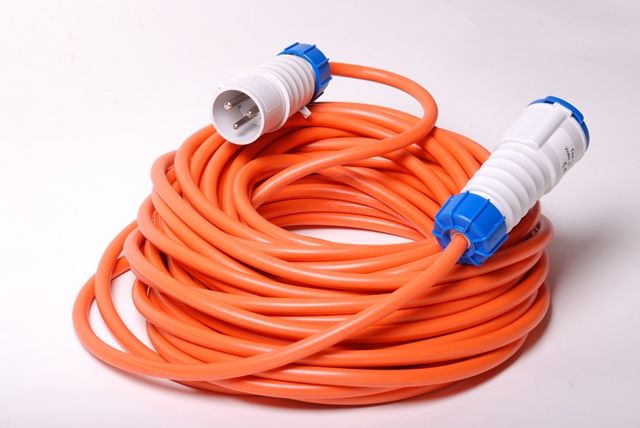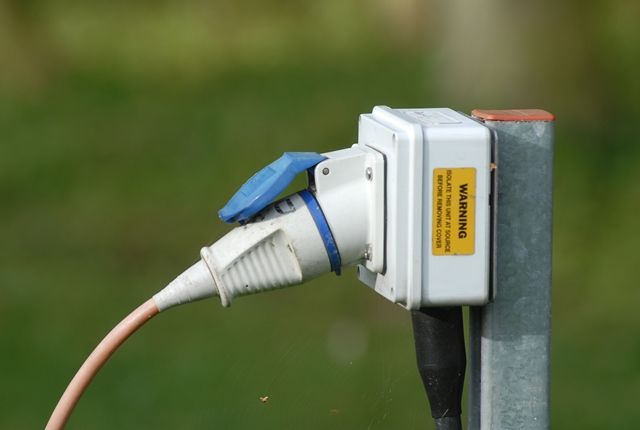Using electricity on a campsite

When you connect to a campsite electric hook-up point you are able to receive an electricity supply as you would at home. Benefit from expert advice, retail discounts and money off pitch night stays when you join the Club.
This will be a nominal 230V, single phase, 50Hz supply, which is compatible with UK and modern European caravans, motorhomes, trailer tents, folding campers and tent hook-up connections.
This electrical supply can be used either directly to power 230V equipment or indirectly via a power supply unit that converts the mains power at 230V AC to a nominal 12V DC, usually in conjunction with a leisure battery. This Data Sheet looks at how to use this electricity supply safely and discusses its limitations.

A site’s electrical supply system should be checked regularly by the site operator
Safety is paramount
Remember that camping on site using a 230V electricity supply within caravans, motorhomes and tents requires even more care than in the home. Because your unit is mobile there is a greater likelihood of things going wrong with an electrical installation than with the fixed installation within your house. It is therefore important you make sure your cables and equipment are maintained in good condition by simple checks every time you use it, by regular inspections by a qualified technician and also by using it in a sensible way.
Campsite owners and management team (in the case of the Club, the Club and its Holiday Site Managers) are responsible for the safety of the electrical supply equipment up to the socket outlet on the site bollard where you connect your hook-up cable. You are then responsible for the safety of the hook-up cable and your unit’s electrical installation. However, the Holiday Site Managers have an overall responsibility for the safety of all campers while on their site, so if a Holiday Site Manager notes any electrical equipment not conforming to the Club’s recommendations or connected to the electrical supply in an unsafe manner he or she is empowered to disconnect that camping unit.
Supply bollard

A typical supply bollard
A pitch with electrical hook-up will have an electrical supply bollard within about 20 metres. Each Club hook-up bollard is individually protected against overload by a miniature circuit breaker (MCB) and a residual current device (RCD).
The MCB is a device to protect the site cabling from overloading and limits the amount of current you can draw from the supply. Hook-ups on Club sites have maximum ratings of 10A or 16A and this will limit the number of appliances you can use at one time (see the How much power section). The RCD is designed to cut off the supply if a fault occurs in your connecting lead, caravan or other camping unit. However, to maximise safety your unit should have its own RCD. Do not allow children to play around the hook-up installation or supply cable or allow them to connect or disconnect supplies.
At Club Sites the supply cable plug is simply a push fit into the bollard socket, but you will find some sites with hook-ups that require the plug to be pushed in and then twisted. With this type of hook-up a button has to be pressed to release the supply cable plug.
Your supply cable
The socket outlet of the Club’s site hook-up points complies with the British Standard BS EN 60309-2. Your connecting lead will need a plug to match this socket outlet and a connector to match the inlet to your unit, both complying with BS EN 60309-2. Such leads now come supplied with new caravans and motorhomes constructed under the National Caravan Council (NCC) approval scheme, but suitable leads fitted with the appropriate blue plug and socket are available from most camping or caravan dealers, these connecting leads must be PVC/PVC flexible cable, with three cores, each core being 2.5mm sq cross sectional area (CSA) to be able to cope with a typical 16A connection demand. It is common however to find lesser cables where each core is only 1.5mm sq CSA. This can be confirmed on the outer PVC covering of the cable where it should be marked. Whichever type of cable you use we highly recommend you fully unwind it to allow any normal heat build up to disapate and avoid overheating of the cable and possible damage.
The maximum cable length of 25 metres should ensure it can reach the supply bollard at most sites in the UK. Always uncoil the supply cable fully to avoid it overheating on a cable reel. The use of a second cable is not recommended, but if it is used it must be fitted with the same BS EN 60309-2 standard plug and connector.
The connection between the two cables should be raised off the ground by the use of a propriety joining cover. Taped cable joints and ordinary 13A household plugs and sockets must not be used under any circumstances. The cable is normally coloured orange so that it is visible and avoids being damaged by grass cutting and other activities on site.

Comparing electrical hook-up cables - the blue one is 1.5mm sq CSA and the orange is 2.5mm sq CSA
Although the electrical standards require a 25m cable with a CSA of 2.5mm sq these are rarely available for sale so if you must get a 1.5mm sq CSA with only 15m of cable consider the following:
- Have an additional cable for pitches more than 15m apart (see note above)
- Get a waterproof connector to join these two cables together safely
- Fully unwind cable from storage reel before use
- Reduce power consumption as the 1.5mm sq CSA cable is not as capable of sustaining maximum electrical power usage on a caravan or motorhome without the cable overheating
- Always make sure it has RCD and MCB protection as a minimum
Connecting up

A proprietary mains tester can be useful when camping abroad
When you are ready to connect to your hook-up, make sure the RCD is in the off position and then connect your hook-up to your unit. Only then should you connect to the campsite hook-up outlet. It is good practice to check the operation of the safety RCD device before turning on your appliances by switching on the RCD and pressing the test button. If it fails to operate the system will need to be checked by a suitably qualified person. As an extra check – especially if you are camping abroad – you can plug a proprietary mains tester into a socket to check the polarity of the supply and the presence of an earth connection (see Camping on the continent).